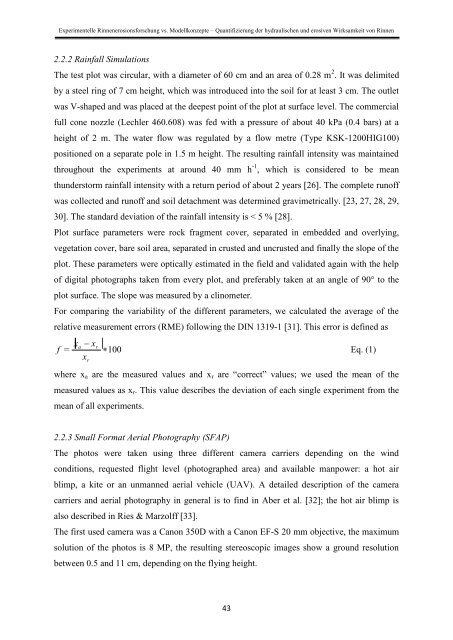Stefan Wirtz Vom Fachbereich VI (Geographie/Geowissenschaften ...
Stefan Wirtz Vom Fachbereich VI (Geographie/Geowissenschaften ...
Stefan Wirtz Vom Fachbereich VI (Geographie/Geowissenschaften ...
You also want an ePaper? Increase the reach of your titles
YUMPU automatically turns print PDFs into web optimized ePapers that Google loves.
Experimentelle Rinnenerosionsforschung vs. Modellkonzepte – Quantifizierung der hydraulischen und erosiven Wirksamkeit von Rinnen<br />
2.2.2 Rainfall Simulations<br />
The test plot was circular, with a diameter of 60 cm and an area of 0.28 m 2 . It was delimited<br />
by a steel ring of 7 cm height, which was introduced into the soil for at least 3 cm. The outlet<br />
was V-shaped and was placed at the deepest point of the plot at surface level. The commercial<br />
full cone nozzle (Lechler 460.608) was fed with a pressure of about 40 kPa (0.4 bars) at a<br />
height of 2 m. The water flow was regulated by a flow metre (Type KSK-1200HIG100)<br />
positioned on a separate pole in 1.5 m height. The resulting rainfall intensity was maintained<br />
throughout the experiments at around 40 mm h -1 , which is considered to be mean<br />
thunderstorm rainfall intensity with a return period of about 2 years [26]. The complete runoff<br />
was collected and runoff and soil detachment was determined gravimetrically. [23, 27, 28, 29,<br />
30]. The standard deviation of the rainfall intensity is < 5 % [28].<br />
Plot surface parameters were rock fragment cover, separated in embedded and overlying,<br />
vegetation cover, bare soil area, separated in crusted and uncrusted and finally the slope of the<br />
plot. These parameters were optically estimated in the field and validated again with the help<br />
of digital photographs taken from every plot, and preferably taken at an angle of 90° to the<br />
plot surface. The slope was measured by a clinometer.<br />
For comparing the variability of the different parameters, we calculated the average of the<br />
relative measurement errors (RME) following the DIN 1319-1 [31]. This error is defined as<br />
xa<br />
xr<br />
f = 100<br />
Eq. (1)<br />
x<br />
r<br />
where x a are the measured values and x r are “correct” values; we used the mean of the<br />
measured values as x r . This value describes the deviation of each single experiment from the<br />
mean of all experiments.<br />
2.2.3 Small Format Aerial Photography (SFAP)<br />
The photos were taken using three different camera carriers depending on the wind<br />
conditions, requested flight level (photographed area) and available manpower: a hot air<br />
blimp, a kite or an unmanned aerial vehicle (UAV). A detailed description of the camera<br />
carriers and aerial photography in general is to find in Aber et al. [32]; the hot air blimp is<br />
also described in Ries & Marzolff [33].<br />
The first used camera was a Canon 350D with a Canon EF-S 20 mm objective, the maximum<br />
solution of the photos is 8 MP, the resulting stereoscopic images show a ground resolution<br />
between 0.5 and 11 cm, depending on the flying height.<br />
43
















